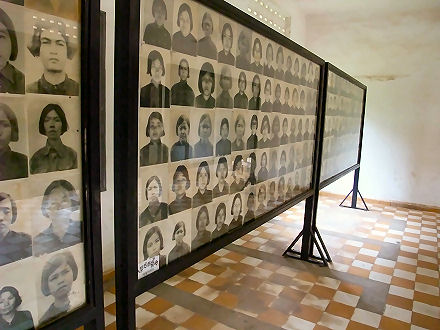All the classrooms were transformed into prison cells and interrogation chambers. Each building has three floors at most. The bottom floor housed the
smallest cells, each holding a single prisoner chained to the floor. Women were confined to the second floor. The third floor
were mass prison cells, holding large groups chained to long
iron bars.
The day in the prison began at 4:30 a.m. when prisoners were ordered to strip for inspection. The guards checked to see if the shackles were loose or if the prisoners had hidden objects they could use to commit suicide.
Ostensibly prisoners were brought here to be imprisoned and interrogated. The unspeakable torture that went on here meant that the
prisoners would confess to anything. School boys confessed to being agents of the CIA, housewives made up stories about their neighbours... not even Communist
higher-ups were immune from this treatment.
S-21 is in Tuol Svay Prey sub-district, south of the capital Phnom Penh. The graves of Tuol Sleng's last victims precede the visitor
entering the complex. After paying the entrance fee, you can walk through by yourself, or get a guide to accompany you. We suggest you do the latter - Tuol Sleng
is almost unremittingly grim, and you'll need someone to put all the death and pain in context.
|
 |
The horrible genius of the Khmer Rouge lay in their attention to detail. Prisoners were photographed and interrogated on their life details before being
chained to their cells. This impersonal collection of data is presented to the visitor, room after room full of photographs of doomed men, women, and children, a glimpse of the estimated
20,000 prisoners who entered Tuol Sleng.
The prisoners were overwhelmingly Cambodian, although the prison did see its share of Americans, British, and Australians. The twisted ideology of
the Khmer Rouge meant that anybody with an education, anybody who wasn't from around there, even anybody who wore glasses was suspect, and could (and often did) end up screaming their lives
out in Tuol Sleng.
You'll also see a torture chamber, left in almost the same condition as they were found by the Vietnamese invaders who kicked the Khmer Rouge out in 1979.
The torture devices are also present, with detailed explanations on how they were used.
The end result of these devices is also nearby - cases of skulls belonging to S-21's unfortunate victims. (Tuol Sleng's most grisly attraction, a "skull map" of
Cambodia in 300-plus skulls, was dismantled in 2002. )

The Vietnamese found Tuol Sleng by following the stench of decay. When they arrived, they found only seven prisoners alive (just barely), and several other less fortunate folk chained to
iron beds, only recently killed by the escaping Khmer Rouge.

Tuol Sleng Genocide Museum
Street 113, Phnom Penh
12210 Cambodia
Phone: +855 23 30 0698
Operating Hours: 7a–11:30a, 2p–5:30p
Getting there: a taxi, moto, or cyclo can take you there from your Phnom Penh
hotel. Admission is US$5, paid at the booth just inside the gate.
Read about Pol Pot
Read about the "Killing Fields".
Read about the Pol Pot's grave.